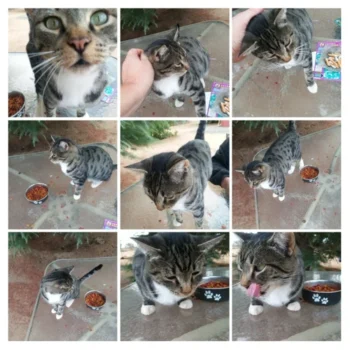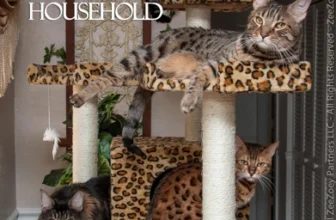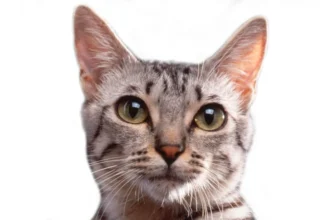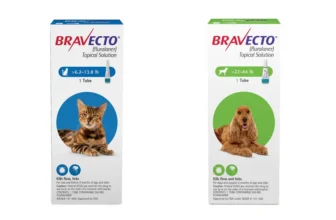As devoted pet owners, we all want to ensure that our feline companions are healthy and happy. Unfortunately, sometimes our California Spangled cats can develop skin conditions that can be uncomfortable, painful, and even dangerous. As a cat owner, it’s crucial to be able to recognize the signs of skin conditions so that you can seek treatment promptly. In this article, we will explore common skin conditions in California Spangled cats, including their signs and symptoms, types, and treatment options. By the end of this article, you’ll have a better understanding of how to keep your feline friend healthy and comfortable.
Signs of Skin Conditions
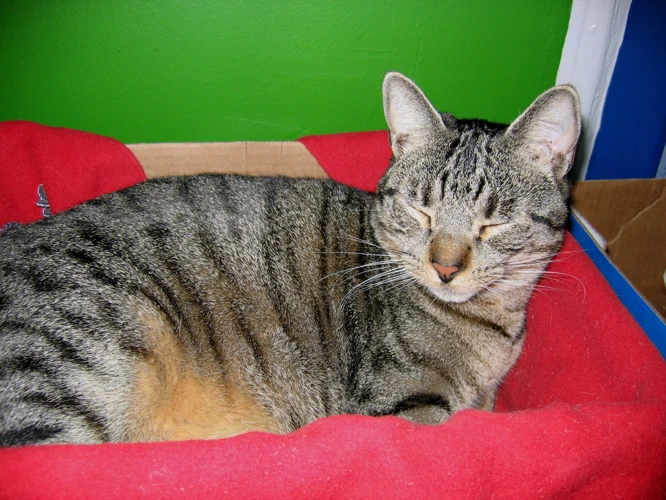
As cat owners, it’s crucial to keep an eye out for any signs of skin conditions that may be affecting our California Spangled cats. Skin conditions can show up as a variety of symptoms that can range from mild to severe. Recognizing these signs is essential in treating skin conditions before they worsen and cause discomfort or even infections. Some skin conditions can even spread to other cats in the household, causing an even bigger problem. Let’s take a closer look at some of the most common symptoms of skin conditions in California Spangled cats that you should be aware of.
Excessive Scratching and Licking
Excessive Scratching and Licking in California Spangled Cats is a clear indication of a skin condition. Many cats will naturally groom themselves, but excessive scratching and licking can cause bald patches and skin damage. If you notice your California Spangled Cat demonstrating this behavior, it is crucial to monitor their skin and consult your veterinarian promptly.
Excessive scratching and licking can be the first sign of an underlying skin condition, such as Flea Allergy Dermatitis, Mites, Fungal Infections, Bacterial Infections, or Allergies. These conditions can cause redness, inflammation, flakes, and scabs on their skin.
One possible factor causing excessive scratching and licking is parasites, such as fleas and mites. Cats with Flea Allergy Dermatitis can experience intense itching and skin irritation due to their hypersensitivity to flea bites.
Another reason for excessive scratching and licking can be a result of environmental or food allergies. For example, if your California Spangled Cat is allergic to dust, pollen, or mold, their skin may be irritated just as their respiratory system would be irritated. Similarly, a food allergy or intolerance can cause skin irritation and itching, leading your cat to scratch or lick the affected area.
If your California Spangled Cat is excessively scratching or licking their skin, it’s essential to observe the area carefully. Look for signs of inflammation, irritation, or hair loss. It is also a good idea to use an online keyword research tool to find out which terms other people use to search. You can include these terms in your article as high-volume keywords.
In the table below, we summarize the common signs of skin conditions to look out for in your California Spangled Cat:
| Signs of Skin Conditions |
|---|
| Excessive scratching and licking |
| Redness and inflammation |
| Flakes and scabs |
If you notice any of these signs in your California Spangled Cat, you should schedule a check-up with your veterinarian to receive a formal diagnosis and treatment plan. Also, consider looking at California Spangled Cat Allergies for more information on environmental and food allergies.
Redness or Inflammation
Redness or inflammation in California Spangled Cats’ skin is a common sign of an underlying skin condition. The affected area may appear swollen, warm to the touch, and often feels itchy to the cat. The redness may be accompanied by the presence of small bumps, pustules, or blisters.
Inflammation can occur due to various reasons such as exposure to allergens, environmental irritants, insect bites, bacterial or fungal infections, or even stress. However, the most common cause of skin inflammation in cats is flea bites, which can trigger an allergic reaction leading to severe itching, scratching, and red skin.
To alleviate redness and inflammation in cats’ skin, a veterinarian may recommend medications and topical treatments. Common medications used for skin inflammation include corticosteroids, antihistamines, or medicated shampoos. Topical treatments such as soothing balms, gels, or sprays may also help in reducing inflammation and redness.
To prevent skin inflammation, California Spangled Cat owners should take measures to identify and eliminate potential irritants from their cat’s environment. Regular grooming and hygiene practices such as bathing and brushing can help remove potential allergens and reduce the occurrence of inflammation.
Additionally, feeding a high-quality diet and minimising stress can help boost the cat’s immune system, making them less susceptible to skin conditions. Keeping the cat’s environment clean and tidy, using hypoallergenic bedding, and washing their toys regularly can also keep them away from irritants.
Taking immediate action when signs of skin inflammation appear is critical in preventing the progression of the condition. If you notice any redness or inflammation on your California Spangled Cat’s skin that doesn’t subside within a few days, consult with a veterinarian to determine the underlying cause and the most appropriate treatment plan.
Flakes or Scabs
Flakes or scabs can also be indications of skin conditions in California Spangled cats. It is common for cats to shed, however, if you observe white flakes or scabs on their fur, then it can be a sign of dry skin or dandruff. California Spangled cats are also susceptible to developing seborrheic dermatitis, which is a skin condition that causes the formation of white or yellow flakes and oily skin.
In addition to that, scabs may also appear on California Spangled cat’s skin due to excessive scratching. This can be a result of various skin conditions which are discussed in detail in the previous section of this article.
If you observe that your California Spangled cat has excessive flakes or scabs on their skin, it is recommended to consult with a veterinarian. They can examine your cat’s skin and determine the underlying cause of the condition.
To prevent excessive dry skin, regular grooming practices should be implemented. Use a soft-bristled brush to remove excess fur and dead skin cells that can contribute to the formation of flakes. Bathing your cat regularly with mild shampoos can also help in keeping their skin moisturized.
Dietary changes can also help alleviate dry skin in California Spangled cats. Provide them with food that is rich in omega-3 fatty acids as it can help in keeping their skin healthy and moisturized.
It is important to eliminate external parasites such as fleas or ticks that can cause excessive scratching and lead to the formation of scabs. Treatment of fleas can involve different options such as shampoo baths, flea collars, and flea medications.
Internal link: To learn more about hairballs in California Spangled cats, check our article on hairballs.
Types of Skin Conditions
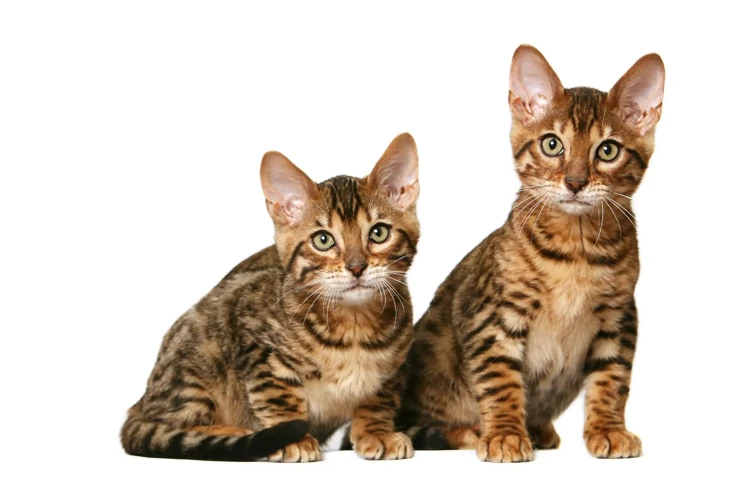
As pet owners, it’s important to keep an eye out for any unusual changes in our cats’ skin. California Spangled cats are no exception. The skin is the largest organ of the body and can be affected by various factors, including genetics, the environment, and diet. In this section, we will discuss some of the most common skin conditions that California Spangled cats may experience. It’s important to note that if you suspect your cat may have a skin condition, it’s best to consult with a veterinarian. On that note, let’s dive into some of the skin conditions that your beloved California Spangled cat may experience.
Flea Allergy Dermatitis
Flea Allergy Dermatitis is a common skin condition that affects California Spangled Cats, triggered by an allergic reaction to flea bites. It is important to recognize the signs of flea allergy dermatitis (FAD) early, as it can cause severe itching and discomfort for cats. Some of the symptoms of flea allergy dermatitis include:
| Excessive itching and scratching | Due to the discomfort caused by flea bites and their saliva, cats with FAD tend to scratch and bite themselves excessively, leading to hair loss and skin irritation. |
| Redness and inflammation | As cats scratch the affected area excessively, the skin becomes red and inflamed. In severe cases, it can lead to open wounds and secondary infections. |
| Papules or scabs | Flea bites can cause small raised bumps on the skin, known as papules. These can become infected and form scabs, further irritating the skin. |
If left untreated, FAD can lead to severe skin infections, so it is important to take preventive measures. Prevention methods include:
– Regular cleaning and vacuuming of the house and cat’s bedding to remove flea eggs and larvae
– Use of flea collars or flea medication to prevent flea infestations
– Regular grooming and bathing of cats to reduce flea populations and remove fleas from the skin
Treatment for FAD includes:
– Consultation with a veterinarian, who may recommend medications to ease itching and prevent infections
– Use of topical creams, shampoos, or sprays to reduce inflammation and control fleas
– In cases of severe itching or infection, corticosteroids or antibiotics may be prescribed
Calming methods such as a stress-free environment, brushing your cat’s teeth, and providing a balanced diet can also contribute to the healing of FAD. If you suspect that your California Spangled Cat is suffering from FAD, it is important to consult with a veterinarian who can recommend the appropriate treatment and preventive measures.
Brushing your cat’s teeth can seem intimidating, but it is an important part of a cat’s overall health.
Mites
Mites are tiny parasites that can cause severe skin problems in cats. The two most common types of mites that affect cats are ear mites and mange mites. Both types of mites can cause intense itching and scratching in cats.
Ear Mites: Ear mites are parasitic insects that live in the ear canal of cats. They are highly contagious, and if one cat in the household has ear mites, then all cats in the household should be treated. Some symptoms of ear mites in cats include excessive itching and scratching around the ears, black discharge in the ears, and head shaking. Continuous scratching or head shaking can also result in skin damage and infection. To treat ear mites, a veterinarian will prescribe appropriate ear drops or topical antiparasitic medication. Regular ear cleaning and grooming can also help keep mites at bay.
Mange Mites: Mange mites, or demodex mites, are another type of parasitic mite that can infect cats. They cause a skin condition known as demodicosis or “mange.” Mange mites burrow under the skin and cause severe itching and hair loss. The affected areas may also become inflamed or develop pustules. Demodicosis most commonly occurs in young or immune-compromised cats. A veterinarian can diagnose demodicosis by performing a skin scraping and examining it under a microscope. Treatment options include specialized shampoo, topical ointments, and/or oral medication. In severe cases, hospitalization may be necessary.
In addition to the treatment options listed above, prevention is key in avoiding a mites infestation. Regularly grooming your cat and checking their ears can help you spot symptoms of mites early on. Keeping your cat’s environment clean and free of fleas is also important, as fleas can be carriers for mites.
If you want to learn about other common health conditions affecting California Spangled cats, check out our article on obesity treatment or UTI treatment.
Fungal Infections
Fungal infections in California spangled cats are not uncommon, and they can cause a range of uncomfortable symptoms and health problems if left untreated. These infections, which are caused by various species of fungi, can affect the skin, hair, and nails of your beloved feline friend.
Signs and Symptoms of Fungal Infections
The symptoms of a fungal infection in your California spangled cat may include hair loss, itchy skin, redness, and the appearance of multiple sores. Your cat may also exhibit signs of pain or discomfort, particularly when the infected area is touched or handled. Fungal infections tend to develop gradually, but they can become more severe if left untreated.
| Signs and Symptoms of Fungal Infections |
|---|
| Hair loss |
| Itchy skin |
| Redness |
| Appearance of multiple sores |
| Pain or discomfort |
Treatment of Fungal Infections
If you suspect that your California spangled cat has a fungal infection, it is important to consult with a veterinarian. Your vet may perform a physical examination, as well as laboratory tests to identify the specific type of fungi causing the infection. Treatment typically involves a combination of medication and topical treatments to eliminate the fungi and prevent their recurrence.
Preventing Fungal Infections
There are several ways you can prevent your California spangled cat from developing fungal infections. These include maintaining good hygiene practices by regularly grooming and washing your cat, providing a balanced and nutritious diet, and keeping your cat’s environment clean and free from mold and other fungi. Additionally, you can keep your cat’s stress levels at a minimum, as stress has been linked to a weakened immune system and increased susceptibility to fungal infections.
If you want to learn more about preventing stress in your California spangled cat, read our article on “Reducing Stress in California Spangled Cats”. If you are concerned about kidney disease in your California spangled cat, read our article on “Early Detection and Management of Kidney Disease in California Spangled Cats”.
Bacterial Infections
Bacterial infections are another common skin condition that can affect California Spangled Cats. These types of infections can occur on any part of a cat’s body and are often caused by various strains of bacteria. Symptoms of bacterial infections may include redness, swelling, itching, and even ulcers or sores.
There are several types of bacterial infections that can affect cats, including:
| Bacterial Infection Type | Symptoms | Treatment |
|---|---|---|
| Pyoderma | Red, itchy, and inflamed skin lesions. May also develop pustules and scabs. | Treatment may include antibiotics, topical treatments, and medicated baths. |
| Cellulitis | Fever, lethargy, and swelling in addition to skin redness and pain. | Antibiotics are typically used to treat cellulitis. |
| Ear Infections | Shaking of the head, scratching at ears, and discharge or odor from the ears. | Antibiotics, topical treatments, and ear cleaning solutions can all be effective treatments for ear infections. |
Treating bacterial infections in California Spangled Cats generally involves the use of antibiotics, either orally or topically. In more severe cases, a veterinarian may recommend medicated baths or other forms of treatment. It is important to follow the full course of treatment prescribed by a vet to ensure that the infection is fully eradicated.
Preventing bacterial infections in cats can often be achieved through proper hygiene practices, such as keeping litter boxes clean and washing bedding frequently. Regular grooming can also help to prevent bacterial growth on a cat’s skin. Keeping a cat’s immune system healthy through a balanced diet and regular exercise can help to prevent the onset of bacterial infections.
Allergies
Just like humans, California Spangled cats can also suffer from various allergies that can manifest as skin conditions. Allergies occur when a cat’s immune system overreacts to a foreign substance, known as an allergen, which can be inhaled or absorbed through the skin.
Common allergens that can affect California Spangled cats include:
- Pollen from trees, weeds, and grasses
- Dust mites
- Mold spores
- Food ingredients such as dairy, chicken, beef, or grains
- Fleas or flea saliva
When a California Spangled cat has an allergic reaction, their skin can become itchy, inflamed, and irritated. They may also develop a rash, scabs, or hair loss. It is important to identify the cause of the allergy and eliminate the allergen in order to prevent further discomfort for the cat.
Treatment for allergies in California Spangled cats may include:
- Antihistamines or corticosteroids to reduce inflammation and relieve itching
- Immunotherapy or allergy shots to desensitize the cat to the allergen
- Elimination diet to identify and remove the allergen from the cat’s diet
- Regular grooming to remove allergens from the cat’s fur
- Controlling the cat’s environment by using air filters or limiting their exposure to potential allergens
It is important to consult with a veterinarian if you suspect that your California Spangled cat has an allergy. A veterinarian can perform allergy testing to identify the allergen and provide the appropriate treatment plan. With proper management and treatment, California Spangled cats with allergies can lead happy and comfortable lives.
Treatment and Prevention
As much as we love our California Spangled cats, they are no strangers to skin conditions. Recognizing the signs early and taking prompt action can relieve discomfort and prevent more severe problems. In this section, we will cover several ways to treat and prevent skin conditions to ensure your feline friend stays healthy and comfortable. From consulting with a veterinarian to making environmental adjustments, we will explore every possible approach that can be used to tackle skin problems in California Spangled cats. Let’s dive in and learn more!
Consulting with a Veterinarian
When you notice any signs of skin conditions in your California Spangled cat, it is essential to consult with a veterinarian as soon as possible. A veterinarian can diagnose the condition and determine the best course of treatment. Here are some steps to take when consulting with a vet:
- Research and choose a reputable veterinarian who specializes in feline health.
- Make a list of symptoms and note any changes in your cat’s behavior or environment.
- Prepare questions to ask the vet, such as the potential causes of the skin condition and the best treatment options.
- During the appointment, provide a detailed history of your cat’s health and any previous skin conditions they may have had.
- Ask the vet to conduct a thorough physical examination, looking for any irregularities on the skin or signs of infection.
- If necessary, the veterinarian may recommend diagnostic tests to determine the underlying cause of the skin condition.
- Listen carefully to the vet’s recommendations on the best course of treatment, including medication, topical treatments, and changes in diet or environmental modifications.
- Be sure to schedule a follow-up appointment to check on the progress of the treatment and make any necessary adjustments.
Remember, consulting with a veterinarian is essential in ensuring your cat’s health and safety. By doing so, you can identify and treat any skin conditions before they worsen and improve your cat’s overall well-being. Don’t hesitate to seek professional help if you notice any signs of skin conditions in your California Spangled cat.
Medications and Topical Treatments
When it comes to treating skin conditions in California Spangled cats, medications and topical treatments are often recommended by veterinarians. These treatments can be highly effective in managing the symptoms of various skin conditions. Below are some of the most common medications and topical treatments used for skin conditions in cats:
- Antihistamines: Antihistamines are often prescribed to manage allergies and can help relieve itching and inflammation.
- Corticosteroids: Corticosteroids are anti-inflammatory drugs that can be used to manage severe skin conditions such as flea allergy dermatitis and atopic dermatitis.
- Antifungal medications: These medications are used to treat fungal infections such as ringworm.
- Antibiotics: Antibiotics may be prescribed to treat bacterial infections.
- Immunotherapy: In some cases, immunotherapy may be recommended to help a cat’s immune system build up a tolerance to allergens that are causing skin reactions.
- Topical treatments: Topical treatments may include medicated shampoos, sprays, or creams. These treatments can help manage symptoms and promote healing.
It’s important to note that these medications and treatments should only be administered under the guidance of a veterinarian. Improper use of medication can lead to adverse reactions and potentially make the skin condition worse. It’s important to keep in mind that some treatments may take several weeks to be effective and that ongoing maintenance may be necessary to manage chronic skin conditions.
Grooming and Hygiene Practices
Keeping up with regular grooming and hygiene practices is crucial for managing skin conditions in California Spangled Cats. Here are some tips and practices that you should follow:
- Brushing their Coat: Regular brushing helps remove excess fur and dander, which can prevent matting and reduce the risk of skin irritation. It also stimulates the skin’s oil production, which helps keep their skin moisturized. Make sure to use a gentle brush and avoid any harsh pulling or tugging.
- Bathing: Bathing can help remove any dirt or allergens that may be causing skin irritation. Use a mild, cat-friendly shampoo and only bathe them once a month or as recommended by your veterinarian. Over-bathing can strip the skin of natural oils and cause dryness.
- Paw Cleaning: Cats walk on their paws all day, accumulating dirt and bacteria. Keeping their paws clean can prevent the spread of infection and skin irritation. Use a gentle wet cloth or unscented baby wipe to clean their paws regularly.
- Ear Cleaning: Regular ear cleaning can prevent bacteria buildup and infections. Use a cat-specific ear cleaning solution and apply a few drops to their ear, then gently massage and wipe away with a cotton ball.
By following these simple grooming and hygiene practices, you can help prevent and manage common skin conditions in your California Spangled Cat. Remember to always consult with your veterinarian for any concerning symptoms or before starting any new grooming routine.
Dietary Changes
Some skin conditions in California Spangled cats can be caused by food allergies or a lack of proper nutrition. Making dietary changes can improve their skin health and prevent future skin issues. Here are some steps to follow when considering dietary changes for your feline friend:
First, start by consulting with a veterinarian to help you identify the best food options for your cat’s specific needs. They can recommend high-quality cat food that is specially formulated to meet their nutritional requirements and avoid potential allergens.
Protein: Protein is crucial for maintaining healthy skin in cats, so make sure to choose cat food that has a high protein content. Look for meats like chicken, turkey, and fish. If your cat is allergic to a particular type of protein, consult your veterinarian for advice on alternative protein sources.
Fats: Fats also play a role in maintaining skin health in cats. Omega-3 fatty acids, in particular, are known to reduce inflammation and promote healthy skin. Look for cat food with added omega-3 fatty acids or consider adding fish oil supplements to their diet.
Carbohydrates: Cats are obligate carnivores, which means that their digestive systems are designed to process animal protein. However, some carbohydrates are necessary for energy and digestive health. Choose cat food that contains healthy carbohydrates like sweet potatoes or peas.
Hydration: Proper hydration is essential for skin health in cats. Make sure that your cat has access to fresh, clean water at all times. Consider adding wet food to their diet, as it contains more moisture than dry food.
By making these dietary changes, you can help ensure that your California Spangled cat is receiving the proper nutrition they need to maintain healthy skin and prevent skin conditions. However, it’s essential to consult with a veterinarian before making any changes to your pet’s diet.
Environmental Adjustments
Another important aspect to consider when treating skin conditions in California Spangled Cats is to make necessary environmental adjustments. Here are some ways to do so:
- Reduce exposure to allergens: If your cat is suffering from allergies, try to identify the triggers and eliminate them as much as possible. Common allergens include pollen, dust, and mold. Invest in an air purifier and regularly clean your home to reduce their presence.
- Provide parasite control: Regularly use flea and tick control measures to prevent infestations and reduce the likelihood of flea allergy dermatitis or mite infestations.
- Minimize stress: Stress can weaken a cat’s immune system and lead to various health problems, including skin conditions. Create a calming environment by providing plenty of hiding spots, regular playtime, and a consistent routine.
- Avoid harsh chemicals: Some cleaning products can irritate a cat’s skin. Opt for natural cleaning solutions and avoid using products that contain strong chemicals.
- Consider the climate: Hot and humid environments can exacerbate certain skin conditions, while dry and cold environments can cause dry skin. Ensure your cat’s environment is comfortable and suited to their needs.
By making these environmental adjustments, you can help prevent skin conditions from developing or worsening in your California Spangled Cat. However, it’s important to note that while these adjustments can be beneficial, they should never be used as a replacement for proper veterinary care. Always consult with a veterinarian before making any significant changes to your cat’s care routine.
Conclusion
After learning about the signs, types, treatment and prevention of common skin conditions in California Spangled Cats, it is clear that these issues should not be taken lightly. As a responsible pet owner, it is our duty to keep our furry friends in the best possible health.
Regular grooming and hygiene practices can go a long way in preventing skin conditions. It is important to keep your cat clean and well-groomed by regularly bathing, brushing, and checking for any signs of abnormalities.
In addition, dietary changes can also contribute to improving your cat’s skin health. Providing them with a well-balanced nutritious diet that meets their dietary needs and keeping them hydrated can contribute to their overall health and well-being.
Taking care of your cat’s environmental needs is also necessary. Regularly cleaning their bedding, toys, and litter box can help reduce their exposure to dirt, dust, and other irritants that might cause skin issues.
However, despite all of our best efforts, sometimes skin conditions happen. If you notice any signs of skin irritation, it is important to consult with a veterinarian. They can help identify the cause of the issue and provide the appropriate treatment plan.
In conclusion, as cat owners, it is crucial to monitor our pets’ skin health and be proactive in managing any issues that may arise. By keeping up with preventative measures and seeking professional help when needed, we can help our California Spangled Cats live a happy and healthy life.
Frequently Asked Questions
What are some common skin conditions found in California Spangled cats?
California Spangled cats are susceptible to skin conditions such as flea allergy dermatitis, mites, fungal and bacterial infections, and allergies.
How can I tell if my California Spangled cat is showing signs of a skin condition?
Signs of skin conditions in California Spangled cats may include excessive scratching and licking, redness or inflammation, and the presence of flakes or scabs on their skin.
What is flea allergy dermatitis, and how is it treated?
Flea allergy dermatitis is an allergic reaction to flea saliva and can cause intense itching, redness, and hair loss in cats. It can be treated with medications to kill fleas and reduce inflammation, as well as flea prevention measures such as monthly spot-on treatments.
What are some common types of mites that can affect California Spangled cats?
Some common types of mites that can affect California Spangled cats include ear mites, sarcoptic mange, and demodectic mange.
How are fungal infections in California Spangled cats treated?
Fungal infections in California Spangled cats can be treated with antifungal medications, shampoos, and/or topical creams. In some cases, oral medications may be necessary.
Are bacterial infections common in California Spangled cats?
Yes, bacterial infections such as pyoderma and cellulitis can occur in California Spangled cats, especially if they have an open wound or compromised immune system.
Can allergies cause skin conditions in California Spangled cats?
Yes, allergies to certain foods, environmental allergens, and flea bites can cause skin conditions such as itching, redness, and inflammation in California Spangled cats.
What should I expect when consulting with a veterinarian about my cat’s skin condition?
During a veterinarian consultation for skin conditions in California Spangled cats, you can expect a physical examination, diagnostic tests such as skin scrapings or biopsies, and a discussion about potential treatment options.
Can grooming and hygiene practices help prevent skin conditions in California Spangled cats?
Yes, regular grooming and hygiene practices such as weekly brushing, bathing, and ear cleaning can help prevent skin conditions in California Spangled cats by removing dirt and debris that can contribute to skin irritation and infection.
What environmental adjustments can I make to help prevent skin conditions in my California Spangled cat?
Environmental adjustments such as eliminating potential allergens such as dust and mold, providing a clean litter box, and avoiding exposure to other cats with known skin conditions can help prevent skin conditions in California Spangled cats.

